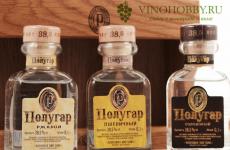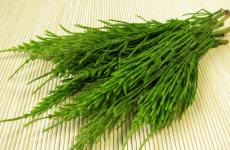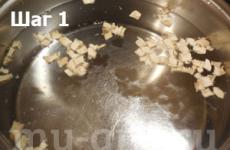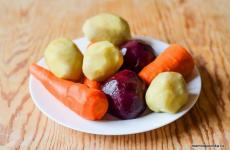Vapor permeability of gas silicate blocks. Vapor permeability of walls - we get rid of fiction. Destructive effects of steam
According to SP 50.13330.2012 "Thermal protection of buildings", Appendix T, Table T1 "Calculated thermal performance indicators building materials and products" the vapor permeability coefficient of galvanized stripping (mu, (mg/(m*h*Pa)) will be equal to:
Conclusion: internal galvanized stripping (see Figure 1) in translucent structures can be installed without vapor barrier.
To install a vapor barrier circuit, it is recommended:
Vapor barrier for fastening points of galvanized sheets, this can be achieved with mastic
Vapor barrier of joints of galvanized sheets
Vapor barrier of joints of elements (galvanized sheet and stained glass crossbar or stand)
Ensure that there is no vapor transmission through fasteners (hollow rivets)
Terms and Definitions
Vapor permeability- the ability of materials to transmit water vapor through their thickness.
Water vapor is the gaseous state of water.
Dew point - The dew point characterizes the amount of humidity in the air (water vapor content in the air). Dew point temperature is defined as the temperature environment, to which the air must cool so that the vapor it contains reaches a state of saturation and begins to condense into dew. Table 1.
Table 1 - Dew point
Vapor permeability- measured by the amount of water vapor passing through 1 m2 of area, 1 meter thick, within 1 hour, at a pressure difference of 1 Pa. (according to SNiP 02/23/2003). The lower the vapor permeability, the better the thermal insulation material.
Vapor permeability coefficient (DIN 52615) (mu, (mg/(m*h*Pa)) is the ratio of the vapor permeability of a layer of air 1 meter thick to the vapor permeability of a material of the same thickness
Air vapor permeability can be considered as a constant equal to
0.625 (mg/(m*h*Pa)
The resistance of a layer of material depends on its thickness. The resistance of a layer of material is determined by dividing the thickness by the vapor permeability coefficient. Measured in (m2*h*Pa) / mg
According to SP 50.13330.2012 "Thermal protection of buildings", Appendix T, Table T1 "Calculated thermal performance indicators of building materials and products" the vapor permeability coefficient (mu, (mg/(m*h*Pa)) will be equal to:
Rod steel, reinforcing steel (7850 kg/m3), coefficient. vapor permeability mu = 0;
Aluminum(2600) = 0; Copper(8500) = 0; Window glass (2500) = 0; Cast iron (7200) = 0;
Reinforced concrete (2500) = 0.03; Cement-sand mortar (1800) = 0.09;
Brickwork made of hollow brick(ceramic hollow core with a density of 1400 kg/m3 on cement sand solution) (1600) = 0,14;
Brickwork made of hollow bricks (ceramic hollow brick with a density of 1300 kg/m3 on cement sand mortar) (1400) = 0.16;
Brickwork made of solid brick (slag on cement sand mortar) (1500) = 0.11;
Brickwork made of solid brick (ordinary clay on cement sand mortar) (1800) = 0.11;
Expanded polystyrene boards with a density of up to 10 - 38 kg/m3 = 0.05;
Ruberoid, parchment, roofing felt (600) = 0.001;
Pine and spruce across the grain (500) = 0.06
Pine and spruce along the grain (500) = 0.32
Oak across the grain (700) = 0.05
Oak along the grain (700) = 0.3
Glued plywood (600) = 0.02
Sand for construction work(GOST 8736) (1600) = 0.17
Mineral wool, stone (25-50 kg/m3) = 0.37; Mineral wool, stone (40-60 kg/m3) = 0.35
Mineral wool, stone (140-175 kg/m3) = 0.32; Mineral wool, stone (180 kg/m3) = 0.3
Drywall 0.075; Concrete 0.03
The article is given for informational purposes
Vapor permeability table- this is a complete summary table with data on the vapor permeability of all possible materials, used in construction. The word “vapor permeability” itself means the ability of layers of building material to either pass or retain water vapor due to different meanings pressure on both sides of the material at the same rate atmospheric pressure. This ability is also called the resistance coefficient and is determined by special values.
The higher the vapor permeability rate, the more moisture the wall can absorb, which means that the material has low frost resistance.
Vapor permeability table indicates the following indicators:
- Thermal conductivity is a kind of indicator of the energetic transfer of heat from more heated particles to less heated particles. Consequently, equilibrium is established in temperature conditions. If the apartment has high thermal conductivity, then this is the most comfortable conditions.
- Thermal capacity. Using it, you can calculate the amount of heat supplied and heat contained in the room. It is imperative to bring it to a real volume. Thanks to this, temperature changes can be recorded.
- Thermal absorption is the enclosing structural alignment during temperature fluctuations. In other words, thermal absorption is the degree to which wall surfaces absorb moisture.
- Thermal stability is the ability to protect structures from sudden fluctuations in heat flow.
Completely all the comfort in the room will depend on these thermal conditions, which is why during construction it is so necessary vapor permeability table, as it helps to effectively compare different types of vapor permeability.
On the one hand, vapor permeability has a good effect on the microclimate, and on the other hand, it destroys the materials from which the house is built. In such cases, it is recommended to install a vapor barrier layer with outside Houses. After this, the insulation will not allow steam to pass through.
Vapor barriers are materials that are used from negative impact air vapor to protect the insulation.
There are three classes of vapor barrier. They differ in mechanical strength and resistance to vapor permeability. The first class of vapor barrier is rigid materials based on foil. The second class includes materials based on polypropylene or polyethylene. And the third class consists of soft materials.
Table of vapor permeability of materials.
Table of vapor permeability of materials- these are building standards for international and domestic standards for vapor permeability of building materials.
|
Material |
Vapor permeability coefficient, mg/(m*h*Pa) |
|---|---|
|
Aluminum |
|
|
Arbolit, 300 kg/m3 |
|
|
Arbolit, 600 kg/m3 |
|
|
Arbolit, 800 kg/m3 |
|
|
Asphalt concrete |
|
|
Foamed synthetic rubber |
|
|
Drywall |
|
|
Granite, gneiss, basalt |
|
|
Chipboard and fibreboard, 1000-800 kg/m3 |
|
|
Chipboard and fibreboard, 200 kg/m3 |
|
|
Chipboard and fibreboard, 400 kg/m3 |
|
|
Chipboard and fibreboard, 600 kg/m3 |
|
|
Oak along the grain |
|
|
Oak across the grain |
|
|
Reinforced concrete |
|
|
Limestone, 1400 kg/m3 |
|
|
Limestone, 1600 kg/m3 |
|
|
Limestone, 1800 kg/m3 |
|
|
Limestone, 2000 kg/m3 |
|
|
Expanded clay (bulk, i.e. gravel), 200 kg/m3 |
0.26; 0.27 (SP) |
|
Expanded clay (bulk, i.e. gravel), 250 kg/m3 |
|
|
Expanded clay (bulk, i.e. gravel), 300 kg/m3 |
|
|
Expanded clay (bulk, i.e. gravel), 350 kg/m3 |
|
|
Expanded clay (bulk, i.e. gravel), 400 kg/m3 |
|
|
Expanded clay (bulk, i.e. gravel), 450 kg/m3 |
|
|
Expanded clay (bulk, i.e. gravel), 500 kg/m3 |
|
|
Expanded clay (bulk, i.e. gravel), 600 kg/m3 |
|
|
Expanded clay (bulk, i.e. gravel), 800 kg/m3 |
|
|
Expanded clay concrete, density 1000 kg/m3 |
|
|
Expanded clay concrete, density 1800 kg/m3 |
|
|
Expanded clay concrete, density 500 kg/m3 |
|
|
Expanded clay concrete, density 800 kg/m3 |
|
|
Porcelain tiles |
|
|
Clay brick, masonry |
|
|
Hollow ceramic brick (1000 kg/m3 gross) |
|
|
Hollow ceramic brick (1400 kg/m3 gross) |
|
|
Brick, silicate, masonry |
|
|
Large format ceramic block(warm ceramics) |
|
|
Linoleum (PVC, i.e. unnatural) |
|
|
Mineral wool, stone, 140-175 kg/m3 |
|
|
Mineral wool, stone, 180 kg/m3 |
|
|
Mineral wool, stone, 25-50 kg/m3 |
|
|
Mineral wool, stone, 40-60 kg/m3 |
|
|
Mineral wool, glass, 17-15 kg/m3 |
|
|
Mineral wool, glass, 20 kg/m3 |
|
|
Mineral wool, glass, 35-30 kg/m3 |
|
|
Mineral wool, glass, 60-45 kg/m3 |
|
|
Mineral wool, glass, 85-75 kg/m3 |
|
|
OSB (OSB-3, OSB-4) |
|
|
Foam concrete and aerated concrete, density 1000 kg/m3 |
|
|
Foam concrete and aerated concrete, density 400 kg/m3 |
|
|
Foam concrete and aerated concrete, density 600 kg/m3 |
|
|
Foam concrete and aerated concrete, density 800 kg/m3 |
|
|
Expanded polystyrene (foam), plate, density from 10 to 38 kg/m3 |
|
|
Extruded polystyrene foam (EPS, XPS) |
0.005 (SP); 0.013; 0.004 |
|
Expanded polystyrene, plate |
|
|
Polyurethane foam, density 32 kg/m3 |
|
|
Polyurethane foam, density 40 kg/m3 |
|
|
Polyurethane foam, density 60 kg/m3 |
|
|
Polyurethane foam, density 80 kg/m3 |
|
|
Block foam glass |
0 (rarely 0.02) |
|
Bulk foam glass, density 200 kg/m3 |
|
|
Bulk foam glass, density 400 kg/m3 |
|
|
Glazed ceramic tiles |
|
|
Clinker tiles |
low; 0.018 |
|
Gypsum slabs (gypsum slabs), 1100 kg/m3 |
|
|
Gypsum slabs (gypsum slabs), 1350 kg/m3 |
|
|
Fiberboard and wood concrete slabs, 400 kg/m3 |
|
|
Fiberboard and wood concrete slabs, 500-450 kg/m3 |
|
|
Polyurea |
|
|
Polyurethane mastic |
|
|
Polyethylene |
|
|
Lime-sand mortar with lime (or plaster) |
|
|
Cement-sand-lime mortar (or plaster) |
|
|
Cement-sand mortar (or plaster) |
|
|
Ruberoid, glassine |
|
|
Pine, spruce along the grain |
|
|
Pine, spruce across the grain |
|
|
Plywood |
|
|
Cellulose ecowool |
The concept of “breathing walls” is considered a positive characteristic of the materials from which they are made. But few people think about the reasons that allow this breathing. Materials that can pass both air and steam are vapor permeable.
A clear example of building materials with high vapor permeability:
- wood;
- expanded clay slabs;
- foam concrete.
Concrete or brick walls are less permeable to steam than wood or expanded clay.
Indoor steam sources
Human breathing, cooking, water vapor from the bathroom and many other sources of steam in the absence exhaust device create high level indoor humidity. You can often observe the formation of perspiration on window glass V winter time, or on cold water pipes. These are examples of water vapor forming inside a home.
What is vapor permeability
Design and construction rules give following definition term: vapor permeability of materials is the ability to pass through droplets of moisture contained in the air due to different values of partial vapor pressures with opposite sides at the same air pressure values. It is also defined as the density of the steam flow passing through a certain thickness of the material.
The table containing the coefficient of vapor permeability, compiled for building materials, is of a conditional nature, since the specified calculated values of humidity and atmospheric conditions do not always correspond to real conditions. The dew point can be calculated based on approximate data.
Wall design taking into account vapor permeability
Even if the walls are built from a material that has high vapor permeability, this cannot be a guarantee that it will not turn into water within the thickness of the wall. To prevent this from happening, you need to protect the material from the difference in partial vapor pressure from inside and outside. Protection against the formation of steam condensate is carried out using OSB boards, insulating materials such as penoplex and vapor-proof films or membranes that prevent steam from penetrating into the insulation.

The walls are insulated so that closer to the outer edge there is a layer of insulation that is unable to form moisture condensation and pushes back the dew point (water formation). In parallel with protective layers V roofing pie it is necessary to ensure the correct ventilation gap.
Destructive effects of steam
If the wall cake has a weak ability to absorb steam, it is not in danger of destruction due to the expansion of moisture from frost. The main condition is to prevent moisture from accumulating in the thickness of the wall, but to ensure its free passage and weathering. It is equally important to arrange forced exhaust excess moisture and steam from the room, connect a powerful ventilation system. By observing the above conditions, you can protect the walls from cracking and increase the service life of the entire house. The constant passage of moisture through building materials accelerates their destruction.
Use of conductive qualities
Taking into account the peculiarities of building operation, the following insulation principle is applied: the most vapor-conducting insulating materials are located outside. Thanks to this arrangement of layers, the likelihood of water accumulating when the outside temperature drops is reduced. To prevent the walls from getting wet from the inside, the inner layer is insulated with a material that has low vapor permeability, for example, a thick layer of extruded polystyrene foam.
The opposite method of using the vapor-conducting effects of building materials has been successfully used. It consists of covering a brick wall with a vapor barrier layer of foam glass, which interrupts the moving flow of steam from the house to the street during low temperatures. The brick begins to accumulate moisture in the rooms, creating a pleasant indoor climate thanks to a reliable vapor barrier.
Compliance with the basic principle when constructing walls
Walls must have a minimum ability to conduct steam and heat, but at the same time be heat-intensive and heat-resistant. When using one type of material, the required effects cannot be achieved. The outer wall part must retain cold masses and prevent their impact on internal heat-intensive materials that maintain a comfortable thermal regime inside the room.
Ideal for inner layer reinforced concrete, its heat capacity, density and strength have maximum indicators. Concrete successfully smoothes out the difference between night and day temperature changes.
When carrying out construction work, wall pies are made taking into account the basic principle: the vapor permeability of each layer should increase in the direction from the inner layers to the outer ones.
Rules for the location of vapor barrier layers
To provide the best performance characteristics multi-layer structures of buildings, the rule applies: on the side with more high temperature, materials with increased resistance to steam penetration and increased thermal conductivity are used. Layers located on the outside must have high vapor conductivity. For the normal functioning of the enclosing structure, it is necessary that the coefficient of the outer layer is five times higher than that of the layer located inside. 
If this rule is followed, it will not be difficult for water vapor trapped in the warm layer of the wall to quickly escape through more porous materials.
If this condition is not met, the inner layers of building materials harden and become more thermally conductive.
Introduction to the table of vapor permeability of materials
When designing a house, the characteristics of building materials are taken into account. The Code of Rules contains a table with information about the coefficient of vapor permeability of building materials under conditions of normal atmospheric pressure and average air temperature.
Material | Vapor permeability coefficient |
extruded polystyrene foam | |
polyurethane foam | |
mineral wool | |
reinforced concrete, concrete | |
pine or spruce | |
expanded clay | |
foam concrete, aerated concrete | |
granite, marble | |
drywall | |
chipboard, osp, fibreboard | |
foam glass | |
roofing felt | |
polyethylene | |
linoleum |
The importance of the vapor permeability table of materials
The vapor permeability coefficient is an important parameter that is used to calculate the layer thickness insulation materials. The quality of insulation of the entire structure depends on the correctness of the results obtained.

Sergey Novozhilov - expert on roofing materials with 9 years of practical experience in the field of engineering solutions in construction.
The table shows the vapor permeability resistance values of materials and thin layers of vapor barrier for common ones. Resistance to vapor permeation of materials Rп can be defined as the quotient of the thickness of the material divided by its vapor permeability coefficient μ.
It should be noted that vapor permeation resistance can only be specified for a material of a given thickness, in contrast to , which is not tied to the thickness of the material and is determined only by the structure of the material. For multilayer sheet materials the total resistance to vapor permeation will be equal to the sum of the resistances of the material of the layers.
What is the resistance to vapor permeation? For example, consider the value of vapor permeation resistance of an ordinary 1.3 mm thick. According to the table, this value is 0.016 m 2 h Pa/mg. What does this value mean? It means the following: through square meter The area of such cardboard will pass 1 mg in 1 hour with a difference in its partial pressures at opposite sides of the cardboard equal to 0.016 Pa (at the same temperature and air pressure on both sides of the material).
Thus, vapor permeation resistance shows the required difference in partial pressure of water vapor, sufficient for the passage of 1 mg of water vapor through 1 m 2 of sheet material of the specified thickness in 1 hour. According to GOST 25898-83, vapor permeation resistance is determined for sheet materials and thin layers of vapor barrier having a thickness of no more than 10 mm. It should be noted that the vapor barrier with the highest resistance to vapor permeation in the table is.
| Material | Layer thickness, mm |
Resistance Rп, m 2 h Pa/mg |
|---|---|---|
| Ordinary cardboard | 1,3 | 0,016 |
| Asbestos cement sheets | 6 | 0,3 |
| Gypsum cladding sheets (dry plaster) | 10 | 0,12 |
| Hard wood fiber sheets | 10 | 0,11 |
| Soft wood fiber sheets | 12,5 | 0,05 |
| Hot bitumen painting in one go | 2 | 0,3 |
| Painting with hot bitumen in two times | 4 | 0,48 |
| Oil painting in two times with preliminary putty and primer | — | 0,64 |
| Painting with enamel paint | — | 0,48 |
| Coating with insulating mastic at one time | 2 | 0,6 |
| Coating with bitumen-kukersol mastic at one time | 1 | 0,64 |
| Coating with bitumen-kukersol mastic in two times | 2 | 1,1 |
| Roofing glassine | 0,4 | 0,33 |
| Polyethylene film | 0,16 | 7,3 |
| Ruberoid | 1,5 | 1,1 |
| Roofing felt | 1,9 | 0,4 |
| Three-layer plywood | 3 | 0,15 |
Sources:
1. Building codes and regulations. Construction heating engineering. SNiP II-3-79. Ministry of Construction of Russia - Moscow 1995.
2. GOST 25898-83 Construction materials and products. Methods for determining vapor permeation resistance.
There is a legend about a “breathing wall,” and tales about “the healthy breathing of a cinder block, which creates a unique atmosphere in the house.” In fact, the vapor permeability of the wall is not large, the amount of steam passing through it is insignificant, and much less than the amount of steam carried by air when it is exchanged in the room.
Vapor permeability is one of the most important parameters used when calculating insulation. We can say that the vapor permeability of materials determines the entire insulation design.
What is vapor permeability
The movement of steam through the wall occurs when there is a difference in partial pressure on the sides of the wall (different humidity). In this case, there may not be a difference in atmospheric pressure.
Vapor permeability is the ability of a material to pass steam through itself. According to the domestic classification, it is determined by the vapor permeability coefficient m, mg/(m*hour*Pa).
The resistance of a layer of material will depend on its thickness.
Determined by dividing the thickness by the vapor permeability coefficient. Measured in (m sq.*hour*Pa)/mg.
For example, the vapor permeability coefficient brickwork accepted as 0.11 mg/(m*hour*Pa). With a brick wall thickness of 0.36 m, its resistance to steam movement will be 0.36/0.11=3.3 (m sq.*hour*Pa)/mg.
What is the vapor permeability of building materials?
Below are the values of the vapor permeability coefficient for several building materials (according to normative document), which are most widely used, mg/(m*hour*Pa).
Bitumen 0.008
Heavy concrete 0.03
Autoclaved aerated concrete 0.12
Expanded clay concrete 0.075 - 0.09
Slag concrete 0.075 - 0.14
Burnt clay (brick) 0.11 - 0.15 (in the form of masonry on cement mortar)
Lime mortar 0.12
Drywall, gypsum 0.075
Cement-sand plaster 0.09
Limestone (depending on density) 0.06 - 0.11
Metals 0
Chipboard 0.12 0.24
Linoleum 0.002
Polystyrene foam 0.05-0.23
Polyurethane solid, polyurethane foam
0,05
Mineral wool 0.3-0.6
Foam glass 0.02 -0.03
Vermiculite 0.23 - 0.3
Expanded clay 0.21-0.26
Wood across the grain 0.06
Wood along the grain 0.32
Brickwork made of sand-lime bricks with cement mortar 0.11
Data on the vapor permeability of layers must be taken into account when designing any insulation.
How to design insulation - based on vapor barrier qualities
The basic rule of insulation is that the vapor transparency of layers should increase towards the outside. Then, during the cold season, it is more likely that water will not accumulate in the layers when condensation occurs at the dew point.
The basic principle helps to make a decision in any case. Even when everything is “turned upside down,” they insulate from the inside, despite persistent recommendations to do insulation only from the outside.
To avoid a catastrophe with the walls getting wet, it is enough to remember that the inner layer should most stubbornly resist steam, and based on this, for internal insulation apply extruded polystyrene foam in a thick layer - a material with very low vapor permeability.
Or don’t forget to use even more “airy” mineral wool on the outside for very “breathable” aerated concrete.
Separation of layers with a vapor barrier
Another option for applying the principle of vapor transparency of materials in a multilayer structure is to separate the most significant layers with a vapor barrier. Or the use of a significant layer, which is an absolute vapor barrier.
For example, insulating a brick wall with foam glass. It would seem that this contradicts the above principle, since it is possible for moisture to accumulate in the brick?
But this does not happen, due to the fact that the directional movement of steam is completely interrupted (at sub-zero temperatures from the room to the outside). After all, foam glass is a complete vapor barrier or close to it.
Therefore, in this case, the brick will enter into a state of equilibrium with the internal atmosphere of the house, and will serve as an accumulator of humidity during sudden changes indoors, making the internal climate more pleasant.
The principle of layer separation is also used when using mineral wool - an insulation material that is especially dangerous due to moisture accumulation. For example, in a three-layer structure, when mineral wool is located inside a wall without ventilation, it is recommended to place a vapor barrier under the wool and thus leave it in the outside atmosphere.

International classification of vapor barrier qualities of materials
The international classification of materials based on vapor barrier properties differs from the domestic one.
According to the international standard ISO/FDIS 10456:2007(E), materials are characterized by a coefficient of resistance to vapor movement. This coefficient indicates how many times more material resists the movement of steam compared to air. Those. for air, the coefficient of resistance to steam movement is 1, and for extruded polystyrene foam it is already 150, i.e. Expanded polystyrene is 150 times less permeable to steam than air.
It is also customary in international standards to determine vapor permeability for dry and moistened materials. The internal humidity of the material is 70% as the boundary between the concepts of “dry” and “moistened”.
Below are the values of the steam resistance coefficient for various materials according to international standards.
Steam resistance coefficient
Data are given first for dry material, and separated by commas for moistened material (more than 70% humidity).
Air 1, 1
Bitumen 50,000, 50,000
Plastics, rubber, silicone - >5,000, >5,000
Heavy concrete 130, 80
Concrete medium density 100, 60
Polystyrene concrete 120, 60
Autoclaved aerated concrete 10, 6
Lightweight concrete 15, 10
Fake diamond 150, 120
Expanded clay concrete 6-8, 4
Slag concrete 30, 20
Fired clay (brick) 16, 10
Lime mortar 20, 10
Drywall, gypsum 10, 4
Gypsum plaster 10, 6
Cement-sand plaster 10, 6
Clay, sand, gravel 50, 50
Sandstone 40, 30
Limestone (depending on density) 30-250, 20-200
Ceramic tile?, ?
Metals?, ?
OSB-2 (DIN 52612) 50, 30
OSB-3 (DIN 52612) 107, 64
OSB-4 (DIN 52612) 300, 135
Chipboard 50, 10-20
Linoleum 1000, 800
Underlay for plastic laminate 10,000, 10,000
Underlay for laminate cork 20, 10
Foam plastic 60, 60
EPPS 150, 150
Solid polyurethane, polyurethane foam 50, 50
Mineral wool 1, 1
Foam glass?, ?
Perlite panels 5, 5
Perlite 2, 2
Vermiculite 3, 2
Ecowool 2, 2
Expanded clay 2, 2
Wood across the grain 50-200, 20-50
It should be noted that the data on resistance to steam movement here and “there” are very different. For example, foam glass is standardized in our country, and the international standard says that it is an absolute vapor barrier.

Where did the legend of the breathing wall come from?
A lot of companies produce mineral wool. This is the most vapor-permeable insulation. According to international standards, its vapor permeability resistance coefficient (not to be confused with the domestic vapor permeability coefficient) is 1.0. Those. in fact, mineral wool is no different in this respect from air.
Indeed, this is a “breathable” insulation. To sell as much mineral wool as possible, you need a beautiful fairy tale. For example, if you insulate a brick wall from the outside mineral wool, then it will not lose anything in terms of vapor permeability. And this is the absolute truth!
The insidious lie is hidden in the fact that through brick walls 36 centimeters thick, with a humidity difference of 20% (on the street 50%, in the house - 70%) about a liter of water will leave the house per day. While with the exchange of air, about 10 times more should come out so that the humidity in the house does not increase.
And if the wall is insulated from the outside or inside, for example with a layer of paint, vinyl wallpaper, dense cement plaster, (which in general is “the most common thing”), then the vapor permeability of the wall will decrease by several times, and with complete insulation - by tens and hundreds of times.
Therefore always brick wall and it will be absolutely the same for household members whether the house is covered with mineral wool with “raging breath”, or with “sadly sniffling” polystyrene foam.
When making decisions on insulating houses and apartments, it is worth proceeding from the basic principle - the outer layer should be more vapor permeable, preferably by several times.
If for some reason it is not possible to withstand this, then you can separate the layers with a continuous vapor barrier (use a completely vapor-proof layer) and stop the movement of steam in the structure, which will lead to a state of dynamic equilibrium of the layers with the environment in which they will be located.






